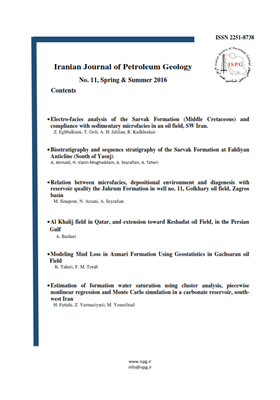Relation between microfacies, depositional environment and diagenesis with reservoir quality the Jahrum Formation in well no. 11, Golkhary oil field, Zagros basin
Subject Areas : Petroleum Reservoir GeologyMaryam Sinapour 1 * , Naser Arzani 2
1 -
2 -
Keywords: Microfacies Diagenesis Reservoir quality Jahrum Formation Well no. 11 Golkhary oil field.,
Abstract :
In this study the relationship between petrographic studies (microfacies, environment of deposition and diagenesis) and petrophysical data of core analysis in order to identify reservoir quality of the Jahrum Formation in well no. 11 at the Golkhary oil field. The Golkhary oil field is located at the west of Qatar-Kazerun fault, in between Binak and Nargesi oil fields. The Jahrum Formation consists of limestone, dolomite limestone and dolomite. Petrographical studies accomplish in two parts microfacies studies led to the recognition of 9 microfacies that were deposited in 3 facies belt tidal flat, lagoon and open marine environment. In diagenesis studies the most important factors included bioturbation, micritization, mechanical compaction, secondary porosity, secondary anhydrite cement, calcite burial cement, stylolites and solution seams, replacement dolomite, dolomite cement and hydrocarbon shows. Porosities identified are intercrystalline, intergrain, intrafossil and intragrain, moldic, fracture, solution along stylolite, solution enlarge and shelter. The results of this study shows that Grain supported MF3 (Bioclast Nummulitidae Rotalia wackestone/ packstone/ grainstone) and MF4 (Bioclast Nummulitidae Orbitolites packstone/ grainstone/ floatstone) due to the presence in the environment energetic, micrite absence, lack of widespread cement, presence of effective porosities includes intergrain porosity and intercrystalline porosity identified are reservoir microfacies. Petrophysical data with high levels of permeability and effective porosity between these two microfacies is the confirmation of the results of petrographic studies.
[1] آقانباتی ، ع.، 1385، زمین شناسی ایران، انتشارات سازمان زمین شناسی و اکتشافات معدنی کشور ، 587 صفحه.#
[2] حسنوند، 1390، بررسی سنگ¬شناسی و دیاژنز مخزن هیدروکربنی آسماری/ جهرم در میدان نفتی گلخاری (بوشهر)، پایان-نامه کارشناسی ارشد، دانشگاه بوعلی سینا، 149 صفحه.#
[3] خطیبی مهر، م.، و ع. معلمی، 1388، مقایسه تاریخچه رسوب گذاری سازندهای جهرم (زاگرس) و زیارت (البرز) بر مبنای فرامینیفرهای بنتیک: فصلنامه زمین شناسی ایران، پژوهشكده علوم پايه كاربردي جهاد دانشگاهي، سال سوم، شماره نهم، صفحه 87-102.#
[4] کرم پور،ب.، م.ر. موسوی، ر. اهری پور و ا. غفرانی، 1388، تفسیر میکروفاسیس ها و توالی دیاژنتیکی سازند جهرم در برش نمونه (جنوب شهرستان جهرم): فصلنامه ی رسوب و سنگ رسوبی، شماره 4، صفحه 57-66.#
[5] مطیعی، ه.، 1372، چینه شناسی زاگرس، سازمان زمین شناسی و اکتشافات معدنی کشور، 563 صفحه.#
[6] معلمی، ع.، م. ح. آدابی، و ع. صادقی، 1388، تفسیر تاریخچه رسوبگذاری سازند جهرم در ناحیه بوشهر بر مبنای روزن¬داران کفزی و ایزوتوپ استرانسیوم: فصلنامه علمی-پژوهشی علوم زمین، سازمان زمين¬شناسي و اكتشافات معدني، سال نوزدهم، شماره 74، صفحه 169-176.#
[7] همایی، م.، 1385، تعیین واحدهای جریان با اتکا به چند روش و استفاده از آن در بررسی خصوصیات پتروگرافی مخزن آسماری/ جهرم میدان گلخاری، گزارش پ-5783، اداره مطالعات زمین¬شناسی مناطق نفت خیز جنوب، 76 صفحه.#
[8] Archie, G. E., 1952, Classification of carbonate reservoir rocks and petrophysical considerations: American Association of Petroleum Geologists Bulletin, 36, 278-298.#
[9] Beavington-Penney, S.J., V.P. Wright and A. Racey 2005. Sediment production and dispersal on foraminifera-dominated early Tertiary ramps, The Eocene El Garia Formation: Tunisia.Sedimentology, 52, 537-569.#
[10] Choquette, P. W. and L. C. Pray, 1970, Geological nomenclature and classification of porosity in sedimentary carbonates: American Association of Petroleum Geologists Bulletin, 54, 207-250.#
[11] Dunham, R. J, 1962, Classification of carbonate rocks: AAPGe Memoir, 1, 108-121.#
[12] Embry, A. F., and E. J. Klovan, 1971, A Late Devonian reef tract on Northeastern Banks Island, NWT (revision of Dunham classification): Canadian Petrolum Geology Bulletian, 19, 730-781. #
[13] Flugel, E., 2010, Microfacies of carbonate rocks, Springer, Berlin, 976.#
[14] Geel, T., 2000, Recognition of stratigraphic sequences in carbonate platform and slope deposites: Empirical models based on microfacies analysis of paleogene deposite in southeastern Spain: Palaeogeography, palaeoclimatology, palaeoecology, 155, 211-238.#
[15] Haynes, S. J. and McQuillan, H., 1974, Evolution of the Zagros suture zone, southern Iran: Geological Society of American Bulletin, 85, 739-744.#
[16] Lucia, F. J., 2007, Carbonate reservoir characterization, An integrated approach: Springer, Berlin Heidelberg, Second Edition, 366.#
[17] Moallemi, S. A., J. Daneshian, and M. Hosseinzadeh, 2014, Lithostratigraphy, Microfacies Investigation and paleoenvironmental reconstruction of Jahrum Formation in the West and North of the Bandar Abass Area, south Iran: Advances in Environmental Biology, 8(4), 963-974.#
[18] Nadjafi, M., A. Mahboubi, R. Moussavi-Harami, and R. Mirzaee, 2004, Depositional history and sequence stratigraphy of outcropping Tertiary carbonates in the Jahrum and Asmari formations, shiraz area (sw Iran): Journal of Petroleum Geology, 27(2), 179 - 190.#
[19] Nafarieh, E., H. Vaziri-Moghaddam, A. Taheri, and A. Ghabeishavi, 2012, Biofacies and palaeoecology of the jahrum Formation in Lar area, Zagros Basin, (sw Iran): Iranian Jornal of Science and Technology, A1, 51 - 60.#
[20] Rasser, M. W., C. Scheibner, and M. Mutti, 2005, Palaeoenviromental standard section for earthy Ierrdian tropical cabonate factories (Corbieres, France; Pyrenees, Spain): Facies, 51, 217-232.#
[21] Romero, J., E. Caus, and J. Rossel, 2002, A model for the paleoeinvironmental distribiution of larger foraminifera baset on late Eocene deposite on the margine of the south Pyicnean basin (SE Spain): Palaeogeography, palaeoclimatology, palaeoecology, 179, 43-56.#
[22] Salimi, Y., M. R. Esfahani, H. A. Bakhtiari, A. Mohammadifard, and A. Damghani, 2013, Conventional core analysis of Golkhari field, Well No: GL#11, Research Institute of Petroleum Industry, Petroleum Engineering Research Division, 24.#
[23] Wilson, J. L., 1975, Carbonate facies in geologic history: Springer, New York, 471. #
[24] Zohdi, A., S. A. Moallemi, R. Moussavi-Harami, and A. Mahboubi, 2014 ,Shollow burial dolomitization of an Eocene carbonate platform, Southeast Zagros Basin, Iran: GeoArabia, 19(4), 17 - 54.#

